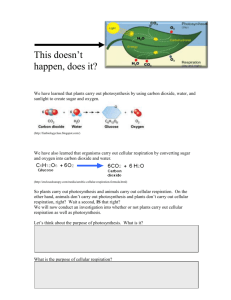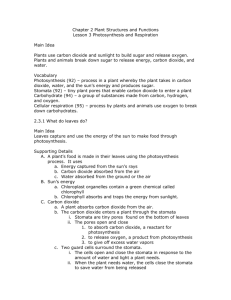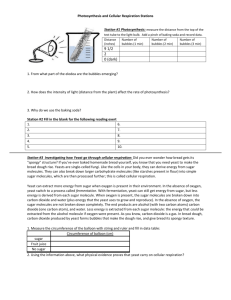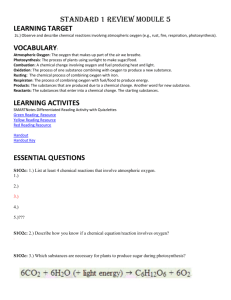Grade Eight - Science - Miami
advertisement
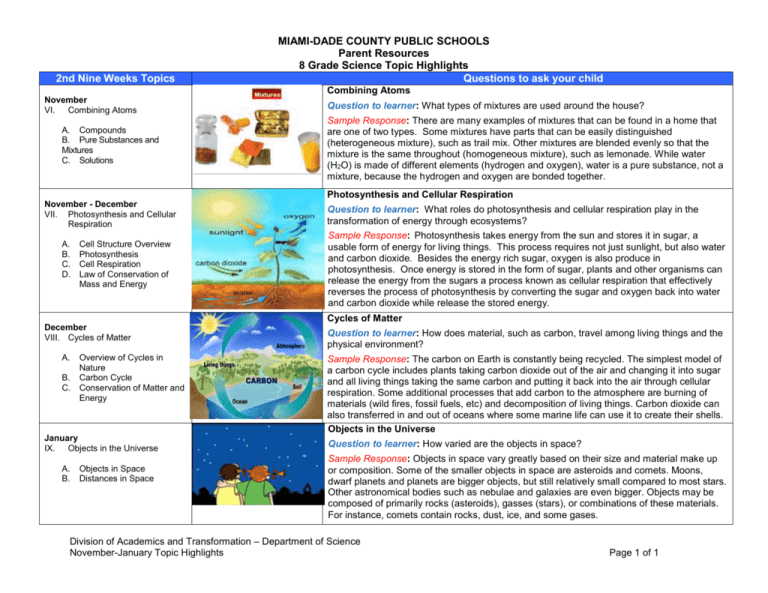
2nd Nine Weeks Topics MIAMI-DADE COUNTY PUBLIC SCHOOLS Parent Resources 8 Grade Science Topic Highlights Questions to ask your child Combining Atoms November VI. Combining Atoms A. Compounds B. Pure Substances and Mixtures C. Solutions Question to learner: What types of mixtures are used around the house? Sample Response: There are many examples of mixtures that can be found in a home that are one of two types. Some mixtures have parts that can be easily distinguished (heterogeneous mixture), such as trail mix. Other mixtures are blended evenly so that the mixture is the same throughout (homogeneous mixture), such as lemonade. While water (H2O) is made of different elements (hydrogen and oxygen), water is a pure substance, not a mixture, because the hydrogen and oxygen are bonded together. Photosynthesis and Cellular Respiration November - December VII. Photosynthesis and Cellular Respiration A. B. C. D. Cell Structure Overview Photosynthesis Cell Respiration Law of Conservation of Mass and Energy Question to learner: What roles do photosynthesis and cellular respiration play in the transformation of energy through ecosystems? Sample Response: Photosynthesis takes energy from the sun and stores it in sugar, a usable form of energy for living things. This process requires not just sunlight, but also water and carbon dioxide. Besides the energy rich sugar, oxygen is also produce in photosynthesis. Once energy is stored in the form of sugar, plants and other organisms can release the energy from the sugars a process known as cellular respiration that effectively reverses the process of photosynthesis by converting the sugar and oxygen back into water and carbon dioxide while release the stored energy. Cycles of Matter December VIII. Cycles of Matter A. B. C. Overview of Cycles in Nature Carbon Cycle Conservation of Matter and Energy January IX. Objects in the Universe A. B. Objects in Space Distances in Space Question to learner: How does material, such as carbon, travel among living things and the physical environment? Sample Response: The carbon on Earth is constantly being recycled. The simplest model of a carbon cycle includes plants taking carbon dioxide out of the air and changing it into sugar and all living things taking the same carbon and putting it back into the air through cellular respiration. Some additional processes that add carbon to the atmosphere are burning of materials (wild fires, fossil fuels, etc) and decomposition of living things. Carbon dioxide can also transferred in and out of oceans where some marine life can use it to create their shells. Objects in the Universe Question to learner: How varied are the objects in space? Sample Response: Objects in space vary greatly based on their size and material make up or composition. Some of the smaller objects in space are asteroids and comets. Moons, dwarf planets and planets are bigger objects, but still relatively small compared to most stars. Other astronomical bodies such as nebulae and galaxies are even bigger. Objects may be composed of primarily rocks (asteroids), gasses (stars), or combinations of these materials. For instance, comets contain rocks, dust, ice, and some gases. Division of Academics and Transformation – Department of Science November-January Topic Highlights Page 1 of 1




